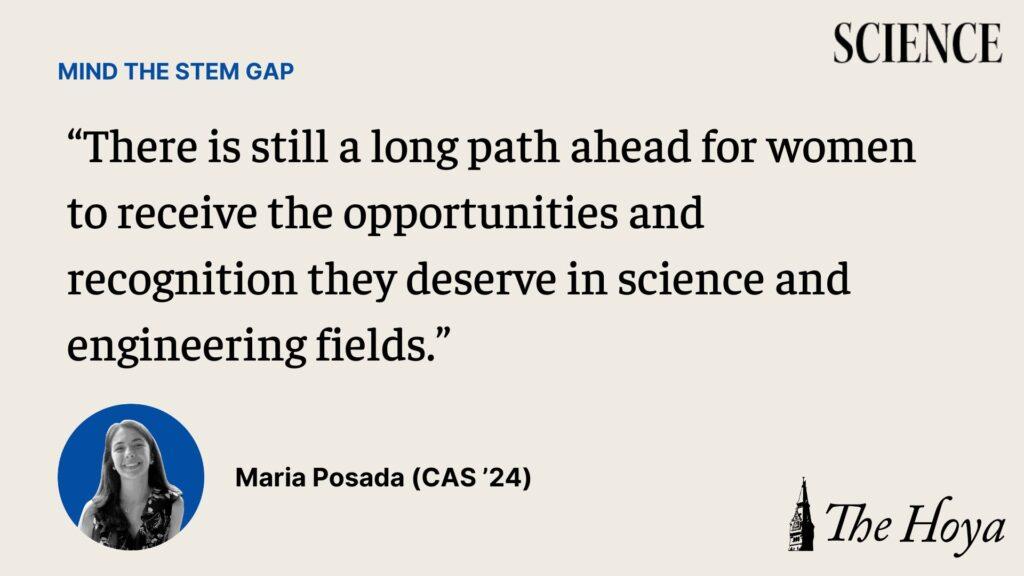Women earn over 60% of biology bachelor’s and master’s degrees and over half of doctoral degrees in biological sciences. With these statistics, it might seem that we have finally closed the gender gap that has been a glass ceiling for women in science for centuries.
But with women comprising only 28% of the workforce in science, technology, engineering and mathematics (STEM), and earning on average $15,000 less than men every year, that gap still looms underfoot. Although progress has been made, there is still a long path ahead for women to receive the opportunities and recognition they deserve in science and engineering fields.
2022 quashed much of the progress that women have spent years fighting for. The overturning of Roe v. Wade, the Taliban’s ban on Afghan girls and women from participating in education and the workforce, and the widespread sexual violence perpetrated by the Russian military against Ukrainian women are just some examples of sexism and injustice in our world today.
These inequalities are also ever-present in our labs, universities and hospitals, preventing female scientists from accessing the same opportunities as their male peers.
Even at educational institutions where members of the new generation of scientific innovators and leaders are taught, gender inequality continues to thrive. For example, at Georgetown there are 1202 male professors compared to only 815 female professors. This discrepancy is particularly stark in the physics department, where only six out of 21 full-time and adjunct faculty are women.
This is a problem because scientists — the very people who depend on accurate samples for their work — are not an accurate sample of the global population. Scientists should ideally represent a microcosm of human diversity. However, while half the global population are women, this is not reflected in the scientific community. Scientific research should be innovating to help everyone so the minds that are doing it should be as diverse — in experiences, race and gender — as the population they represent.
I have too often heard the claim that this is because women are less interested in science careers or do not excel at science compared to men. However, several studies reveal that women are equally well-prepared for careers in science. While the study showed that women tend to “overlook” careers in STEM, this may not be because of an intrinsic disinterest in science, but rather because of sociocultural factors such as stereotypes and misconceptions which serve as obstacles to women’s entry into science careers. Misconceptions about a woman’s place in science continue to plague educational institutions, the industry and society as a whole.
These misconceptions affect women in myriad ways. A 2014 study found that two out of every three women surveyed felt that they had to prove themselves over and over. Women’s job expertise and preparedness are questioned more than their male counterparts.
Many women also cite a lack of female role models as a deterrent from pursuing scientific careers. From high school teachers to Nobel Prize winners, there are not enough women who can serve as leaders and mentors for young people thinking about their career prospects.
With fewer women in science academia, fewer research opportunities are given to women, and, as a result, female science students have fewer women role models. This creates a self-perpetuating problem.
Women scientists with children encounter yet another barrier: maternal wall bias, or the misconception that mothers or pregnant women are less competent and committed. Nearly two-thirds of these scientists with children expressed that they were offered less opportunities during and after pregnancy. Working mothers’ competence and commitment are both questioned, stunting their potential for career growth.
However, it is not only workplace representation that is at stake. The absence of women in STEM tangibly reduces the quality of science being produced by disregarding the female perspective.
This disparity can be clearly seen in the medical field. Women’s health is often neglected in research, with the allocation of funding going to research for diseases which are significantly more likely to affect men.
Shockingly, women are more likely than men to die in car crashes simply because crash dummies are modeled only after male anatomy. Artificial Intelligence (AI) may also prove to show bias against women, especially women of color, if it falls under the pattern of using the white male body as a norm as science has in the past to find new drugs and to create standards of care.
As an educational institution, Georgetown University is far from demonstrating gender equality in the sciences. While this is not a problem that can be fixed overnight, it is important for the university to take intentional steps towards including women in STEM. After all, as a university, Georgetown has the opportunity to make a huge impact on the formation of the new generation of female science innovators.
Though the role and recognition of women in STEM have increased over time, there is still a long way to go. As young female scientists, we must keep fighting for our space in science. As members of a global community, we must elevate the voices of women scientists who have changed the world with their discoveries and yet remain widely unrecognized.









